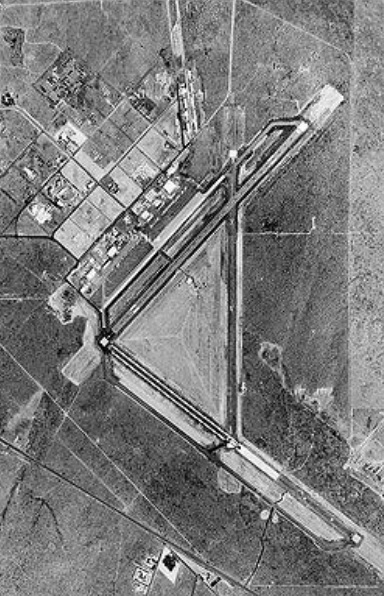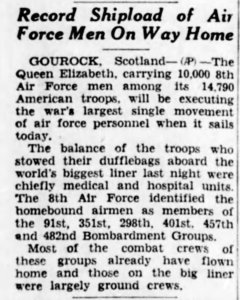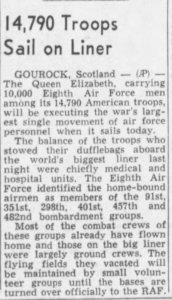EIGHTH AIR FORCE
EIGHTH BOMBER COMMAND
1ST BOMBARDMENT DIVISION
457th BOMBARDMENT GROUP
457th Heavy Bombardment Group, 1st Air Division, Eighth Air Force B-17’s
Activated 1 july 43, Geiger Field, Washington
Elements: 748, 749, 750 and 751 Heavy Bombardment Squadrons
During its tour of operations in the European Theatre of Operations the 457th fortress Group has completed 236 missions over enemy territory, including 18 attacks on Berlin area. Operations covered period from 21 February 1944 to 20 April 1945.
The group wound up its career in the European Theatre of Operations with excellent record of achievement on the last few targets. Among these were installations in Regensburg, Flakenburg, and Seddin there were other missions which the group will long remember. For reasons other than terrific devastation wrought the enemy.
There was the 2 November mission to Merseberg during which nine air-craft were shot down by enemy fighters; there was the mission to Poliz on 7 October when the group encountered terrific antiaircraft fire, which accounted for the loss of many key personnel including Colonel James R. Luper, Portland, Orgeon, Commanding Officer; Major Norman A. Kriehn, Group Navigation Officer; Captain Henry P. Loades, Group Bombardier, and Major Gordon H. Haggard, Group Surgeon. Colonel Luper was recently repatriated from a Prisoner of War Camp. Present Commander is Colonel Harris E.D. Rogner, Masury, Ohio, formerly Air Executive Officer of the 94th Combat Wing.
ACTIVATION
1 July 1943
The 457th Bombardment Group (H), consisted of Group Headquarters and the 748th, 749th, 750th and 751st Bombardment Squadrons (H), was activated under General order number 78, Headquarters, Second Air Force, Fort George Wright, Washington, Section number 1, paragraph number 1, quoted as follows:
“ Pursuant to instructions contained in Restricted War Department
Letter AG-322 (5-18-43) OB-I-AFRPG-M, 19 May 1943, Subject: consti-
tution and activation of certain Army Air Forces Units, the follow-
ing units, having been constituted and assigned to the Second Air
Force, are activated as indicated:
DATE OF
UNIT STATION OF ACTIVATION ACTIVATION
HQ. 457th BOMBARDMENT GROUP (H) AAB, GEIGER FIELD, WASH. 1 JULY 1943
748th BOMBARDMENT SQUADRON (H) AAB, GEIGER FIELD, WASH. 1 JULY 1943
749th BOMBARDMENT SQUADRON (H) AAB, GEIGER FIELD, WASH. 1 JULY 1943
750th BOMBARDMENT SQUADRON (H) AAB, GEIGER FIELD, WASH. 1 JULY 1943
751st BOMBARDMENT SQUADRON (H) AAB, GEIGER FIELD, WASH. 1 JULY 1943
General Order number 78 was by command of Major General Johnson by Aubry L. Moore, Colonel, G. S. C., Chief of Staff.
The initial cadre was formed from the 395th Bombardment Group (H) at the Army Air Base, Ephrata, Washington. Colonel Herbert E. Rice was assigned as Group Commander. The permanent station of the 457th Bombardment Group (H) is at the Army Air Base, Geiger Field, Spokane, Washington.
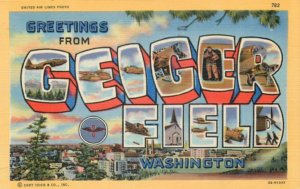 Geiger Field WWII postcard
Geiger Field WWII postcard
The Air Eschelon stayed at Wendover Army Air Base until 4 january, awaiting weather suitable for flying for the POM inspection.
At this time they were ordered to fly to Grand Island, Nebraska, Army Air Base. The planes left Wendover individually for the next two or three days. Six arrived at Grand Island; twenty-three in North Platte, and the remaining ships scattered at various air bases in that vicinity. This was due to continued bad weather, all ships being unable to land at Grand Island.
During this flight, Lt. Ashby’s plane crashed and 6 were killed, 5 bailed out.
Here under the jurisdiction of the 21st Wing, Group was assembled on 8 January, passed the POM inspection with flying colors by splendid Formation flying and accurate bombing on 12 January
The aircraft left Grand Island 17 January, part of them landing at Presque Isle, Maine and part at Grenier Field, Manchester, New Hampshire. From there the planes flew individually, some making landings at various points such as Gander Lake, Newfoundland, Prestwick, Scotland, Nuts Corner, Ireland, finally arriving at the Army Air Base, Glatton, 22 January to 1 February, with the exception of Major Wilson’s crew who came in about three weeks later.
From 1 February to 15 February the crews had intensive ground school training which consisted of indoctrination and pre-operational instruction. The aircraft were send to Burtonwood for final modification.
On 29 December 1943, Major Conselman, the Ground Executive, Major Chalfant, the Operations Officer, Capt. Nelson, S-2 Officer, Capt. Herbert, Communications Officer, left Wendover Field and flew via ATC to Glatton.
ORLANDO, FLORIDA
AUGUST 5 to AUGUST 29, 1943
Under the provisions of Special Orders number 28, paragraph numbers 2 and 3, Headquarters, 17th Bombardment Training Wing, Army Air Camp Rapid, Rapid City, South Dakota, dated 29 July, a part of the 457th Bombardment Group (H), consisting of 130 officers and enlisted men, left on 2 August 1943 for the Army Air Forces School of Applied Tactics, Orlando, Florida, arriving At their destination on 5 August 1943
Durin the last two weeks of August 1943 the 457th Bombardment Group (H), under the direct command of Lt. Colonel Hugh D. Wallace, held combat maneuvers at Brooksville Field, Florida, the missions consisting of seven over-water flights as follows:
1. Charleston, South Carolina, Target #9, 9/20/43, 6 B-17’s, simulated
Target: Wilhelmshaven
Target: Charleston Ship Building Co. – Floating Docks, grass and
foundries. Dimensions: 1800’ L., 900’ W.
2. Wilmington, North Carolina, Target #13, 8/21/43, 6 B-17’s.
Target: Ship Yards and Warehouse Area. Dimensions: 4625’ L., 362’ W.
3. New Orleans, Louisiana, Target #14, 8/22/43, 6 B-17’s.
Target: Banana Docks Area – Warehouses. Dimensions: 4800’ L., 660’ W.
4. Whale Rock – near Isle De Desterrada, Gulf of Mexico. 8/23/43, 4 B-17’s.
Target: Harbor. Location: 22° 35’ N., 89° 47’ W.
5. Gulf of Mexico – Convoy and searchlight Mission. 8/24/43, 6 B-17’s.
Six Ships in convoy. Location: 26° 22’ N., 80° 00’ W.
6. Corpus Christi, Texas, 8/26/43, 4 B-17’s.
Target: Power House. Location: 27° 02’ N., 97° 37’ W.
7. Natchez, Missisippi, 8/27/43, 6 B-17’s. Simulated Target: Natchez
Railroad Bridge. Dimensions: Four 150-foot spans, 16 feet wide.
Location: 31° 30’ W. Construction: 4-span steel bridge,
3 concrete piers.
Upon completion of the course, this part of the cadre, under the provisions of the aforementioned Special Orders number 28, left Orlando, Florida, on 29 August 1943, arriving at Camp Rapid, Rapid City, South Dakota, on 2 September 1943.
The Crews in the Flight Eschelon were authorized to travel by air and the Ground Eschelon proceeded by rail. This was a temporary change of station.
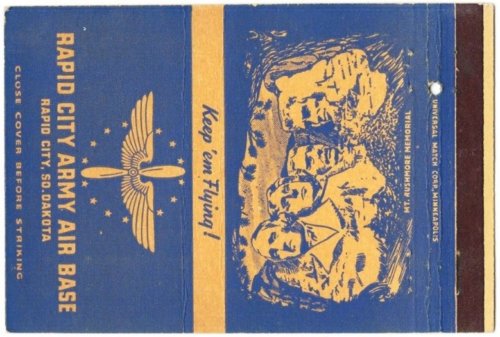 Matchbox Rapid City Army Air Base
Matchbox Rapid City Army Air Base
NARRATION
1 October 1943 to 24 December 1943
Second Lieutenant John E. Dineen became Group Historian as of 10 November 1943.
Field training of combat personnel in preparation for phase training was continued at Camp Rapid, Rapid City, South Dakota, until 25 October 1943, on which date the Group departed for the Army Air Base at Ephrata, Washington. This movement was authorized by Special Orders No. 291, paragraph No. 13, HeadquartersRapid City Army Air Base, Rapid City, South Dakota, dated 23 October 1943.
On their arrival at Ephrata on 28 October 1943, the Group began first and second phase training. Weather conditions throughout their stay there were bad and not at all conductive to phase training so fas as flight was concerned. The bad flying time was though well utilized in giving both the combat crews and ground eschelon a thorough and complete ground schooling.
Despite the atrocious flying conditions the group was comparatively fortunate insofar as fatal accidents were concerned. They lost but one ship, six officers, and one enlisted man. This ship went out of control on the night of 20 November 1943 over Wilson Creek, Washington, and plunged to its destruction. Six officers and one enlisted man elected to ride it down and lost their lives. Four Sergeants parachuted to safety.
First and second phase training having been completed under the above described adverse circumstances, the group departed from Ephrata, Washington, on 2 December 1943 arriving at AAB Wendover Field, Utah, on 4 December 1943. This movement was authorized by Special Orders No. 330, paragraph No. 1, Headquarters AAB, Ephrata, Washington, dated 26 November 1943.
Ephrate Army Air Field
Third phase training was immediately begun at Wendover Field under weather conditions that were generally fair. This phase proceeded at a rapid and efficient pace to a point where we can at the date this is being written, viz, 25 December 1943, state that the combat crews have improved to that point where there is little doubt of their ability to succesfully pass the imminent POM inspection.
The group in this phase was again, considering the tempo at which it was conducted, comparatively fortunate in its few fatalities. They suffered the loss of but one ship, four officers, and four enlisted men. These losses were the result of a mid-air collision near the Air Base on the evening of 23 December 1943. The officers and enlisted men above enumerated plunged to their deaths with their ship. The other ship involved in the collision was with rare skill landed at the Base with no injuries to its personnel.
During the training of the combat crews, the ground eschelon had also been readied for overseas movement by being amply equipped and properly oriented.
In the Group Historian’s opinion the 457th Bombardment Group (H) is on this Christmas Day 1943 prepared physically, technically and insofar as morale concerned to take its place at the fighting front alongside of its so many worthy predecessors from the Second Air Force.
Captain Kenneth R. Luck was appointed Group Historian as of 1 March 1944, and ordered to bring the Group History up from 24 December to the present date.
24 December 1943
Major Clarck was relieved from duty as Commanding Officer of the 748th Bombardment Squadron (H) 24 December 1943. Captain LeRoy Watson replaced him. The entire personnel of the Squadron was greatly disappointed in that Major Clark was very popular with officers and men of the Squadron.
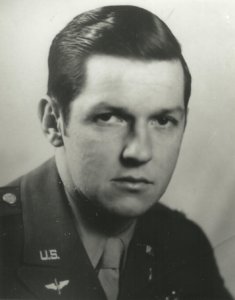 Captain LeRoy Watson
Captain LeRoy Watson
Many parties were held by various departments of the Group Christmas Eve. Christmas Day was observed as a holiday. The next two days were spent feverishly preparing for the POM inspection which occurred on the 28th and 29th. The Group eschelon successfully passed this inspection, however the weather was so foggy it prevented flying, so the Flying Eschelon was to wait indefinitely. The last two days of the year were spent by all hands actively participating in preparation for leaving for POE.
1 January 1944
The Group Eschelon group left Wendover Field, Utah New Year’s Day 1944, broken into four equal units each traveling by separate train and over slightly different routes arriving at Camp Shanks, New York on 5 January. The C-2 Officers reported to the Base Intelligence to receive instructions on security and censorship. After three days of concentrated processing, the personnel of the Group were granted 12-hour passes with 50% of the Group strength off each night.
14 January 1944
The Group was alerted on 14 January at which time tight censorship and confinement was inflicted on all personnel. On the 17th we went in various units by devious means to our boat which was anchored off Staten Island pier. We concluded the convoy would be of considerable strength. The Group fell out with horse-shoe packs at 10.30PM night of the 17th, left the area at 11.30 and entrained for New York City at 11:55. Took ferry boat down Hudson River to Staten Island, arriving there at approximarely 2:00 AM 18 January 1944. It was quite a strenuous trip with the pack, equipment and weapons. There were members of other Groups as well as ours and the ship was terribly crowded. We left about 11:00 AM and it being a foggy day saw the last of the Coast at approximately noon.
(Many other troopships brought 457th Bomb Group personnel from the US to the UK. A couple of these ships were: U.S.S. Lyon, Queen Mary)
The officers has mess three times a day, each mess consisted of three shifts in conjunction with the Naval ship officers. Food was quite good, also the service. The enlisted men seemed to have a continual mess line. Estimate the convoy to be at somewhat over 20 ships. Proceded in a northerly direction for rendezvous off Boston with more ships to complete the convoy. Water is scarce as hell. Had boat drill this afternoon which consisted of massing the men on the top deck and getting everyone out of the hold in any emergency in order to abandon ship. A few men are seasick.
20 January 1944
Still traveling in a northerly direction. Picked up balance of convoy last night. Sea is rather rough and many more men are seasick.
21 January 1944
The weather was very mild. We obviously were in the Gulf Stream – quite comfortable on deck with just a field jacket. All ships had target practice this morning which was very interesting. Some of the gunners seemed quite accurate which increases the feeling of security. The convoy was a beautiful sight. The sea at present was as smooth as a lake. There were approximately 50 officers in one room which wasn’t greater then 25 feet square. Sleeping in 4-tiers high, air was terrible stank and foul. The men were quartered in four holds of the ship sleeping in tiers 6 high – it was dirty and filthy and unsanitary and certainly a hell of a way to carry men to war.
22 January 1944
It rained all morning and the surface was quite rough but there was very little pitch and roll and seemed to be a very good sailing ship.
23 January 1944
The sea was rough as the devil this morning and a great many more men are seasick. Saw a short Sunderland and two Liberators fly over the convoy at different times today. Reports are they are looking for a sailor who was swept overboard from one of our escorting destroyers.
24 January 1944
Learned today that we had 18 destroyers or double escort. Visability was not good. We were unable to see all of them and ships are stretching to the horizon as fas as we can see.
25 January 1944
The ocean is again rough as the devil, however not so many men are seasick. Understand there are nearly 2,000 men, 125 officers on this transport with a naval crew of approximately 360.
27 January 1944
Still rough as hell today. We had turkey and all the trimmings for
28 January 1944
Many runors about subs and sub contacts last night, all without confirmation. There were also rumors that we will be stationed in Scotland. Convoy split up during the night. At noon today we were dimly able to see land on the horizon – Ireland was on our right or east. We were running along its west coast. At 6:00 PM at North Ireland the engines of the ship broke down and we had to drop anchor for at least 3 hours in the Irish sea. The convoy continued on its way. The Queen Mary just passed us going in. Tonight we anchored in the harbor at Grenock. Scotland was on our left and Ireland on the right. Everyone was issued K-rations for 3 meals and ammunition for the guns were also issued in the afternoon. Repairs on the boat were completed and we got under wat at approximately 8:00 PM Friday night.
29 January 1944
All of our convoy seemed to be anchored in this harbor with many other ships. It was a very impressive sight. The Queen Mary was not far off and at least 8 aircraft carriers in this harbor. The country surrounding the harbor is beautiful, hilly, green, small farm land. The town of Grenock is built on the side of the mountain, looks like an ancient city. Homes are built mostly of stone and quite impressive. It was quite cloudy but the sun shined through now and then. It is cool, crisp, but not terribly cold. The S-2 officers devoted severall hours today censoring mail. Quarters were terribly cramped and crowded. It was a wonder we were not all lousy as well as sick from the filth. Plimbing was in bad shape and practically no water. Can’t understand how the medics tolerate such lack of sanitation.
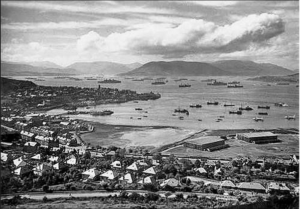 WWII convoy in Gourock harbor (Greenock, Scotland)
WWII convoy in Gourock harbor (Greenock, Scotland)
30 January 1944
Laid in the mouth of the Clyde until nearly 3:00 PM, then moved up to Glasgow where we docked at approximately 5:00 PM. Slept aboard ship tonight. Ship building activity along the Clyde River was beyond all imagination. Tonight Col. Caruthers spoke to all men aboard over the PA system, introduced Gen. Thompson (Lt. General) who received us on behalf of the English Air Ministry. The banks were lined with waiting people which might indicate that we are something of a novelty this far up the river.
1 February 1944
Disembarked at 8:00 AM after we had breakfast and stayed on dock until late that afternoon. However the officers returned to the boat for lunch, and the Red Cross served the men sandwiches and coffee. The Group was divided into 3 units, boarded 3 trains leaving approximately an hour apart at 3:00, 4:00 and 5:00 PM traveling south along the North Sea after going through Edinburgh, and as the trains went through Newcastle, the Red Cross served hot coffee and do-nuts to the personnel. The trains arrived in the small town of Holme approximately 10 miles south of Peterborough from 3:00 AM until about 8:00 AM Tuesday morning.
2 February 1944
We were all formally introduced to the new Commanding Officer, Colonel Luper. Colonel Wallace was relieved of the command on 4 january and Colonel Luper took over. Major John Chalfant, our Group Operations Officer has been relieved from duty and transferred to the 306th Bombardment Group (H), which we all regret very much as he was one hell of a fine fellow. He has been replaced by a Major Kenneth Becord who seems to be a fine fellow, but we always hate to lose a good man. The weather is cold, every bit in the hut as on the outside, the stove supplied each hut is all of 8 inches in diameter and ridicuously inadequate and coke is rationed. We have iron cots, 4 good blankets which seems to be one-third enough, although we have new clean sheets we don’t use them because it is too cold. We can’t complain and will certainly endure these quarters especially when we think of what the infantry goes through in some of the other theaters. All S-2 officers have to report to Division Headquarters at Brampton tomorrow morning. We understand we are to have one day off per week and be able to accumulate to two days in addition to 7-day leave every 3 months.
5 February 1944
The mission today was Frankfurt. Our Group should be operational within a few days. Lt. Dineen was made Public Relations Officer for the Group. Most of the officers cabled their wifes of their safe arrival. Cigarettes are rationed to 7 packs per week per man, candy two bars, two razor blades, one bar of soap, two boxes of matches, one pack chewing gum. All Division personnel as well as personnel of surrounding groups seem to want to be very helpful, a spirit that should prevail and certainly should facilitate our early operational status.
6 February 1944
Major Wilson’s airplane and 2 or 3 others have not as yet arrived. There is some feeling of concern since we have not had definite word from them. The Flying Eschelon has been here well over 2 weeks. The planes have been sent to the Modification Center in order to have them equipped completely with everything necessary to go to war. There was considerable mail on hand here and while there is surely more to come, it helps all the men a lot to be able to have letters from home. Today another mission was to Frankfurt.
7 February 1944
Foor lockers have arrived and most everything seems to be coming through alright.
9 February 1944
We had a practice mission or dry run which was very valuable in that it showed up several of our shortcomings, which doubtless we will be able to improve upon it and run as good a mission as any group in this theater. Having seen at least 3 other S-2 groups in action, I am personally convinced the personnel of our S-2 section is equal to any of them.
14 February 1944
The mission we worked on all night which was to be our first, was ultimately scrubbed. Several members of our Group; Col. Luper, Capt. Frances, Capt. Dickinson, Capt. Watson, and Capt. Spencer have flown as observers on operational missions with other groups so we are getting some reports as to what it is all about. Capt. Dickinson was on the raid last night with another group and reported today he was wounded and is in a hospital in London – understand nothing serious.
19 February 1944
We had a purple then red alert. We checked all our lights to see if anything was visible from the outside because apparently German aircraft were very close overhead. Half an hour later the “ all-clear” was sounded without any excitement whatsoever.
Group had its first party for the officers, held in celebration of the opening of the Officers Club. Was quite a succes in thet there was plenty of liquor and quite a few girls.
21 February 1944
The Group went out on the first mission on the second day of Operation Big Week. 235 missions would follow!
1 June 1945
Starting from June 1 1945 the B-17’s started flying back to the US. They were soon followed by the ground personnel who moved out by train (leaving from Holme train station) in three stages with the last section leaving on June 22 1945 and arriving at Gourock, Scotland on June 24th 1945. There they boarded the Queen Elizabeth for the long trip home.
12 July 1945
On July 12th 1945 Glatton was handed over to the RAF and soon became NO. 70 Transit Camp for homecoming Allied POW’s. On August 1st 1945 operation Dodge started ferrying, in a month period, 13,000 ex-POW’s to Glatton in Lancasters and Liberators. On January 15th 1946 operation Dodge finished by which time NO. 70 Transit Camp processed 36,799 passengers. Glatton closed in March 1946. The 457th Bomb Group was inactivated on August 28th 1945.


